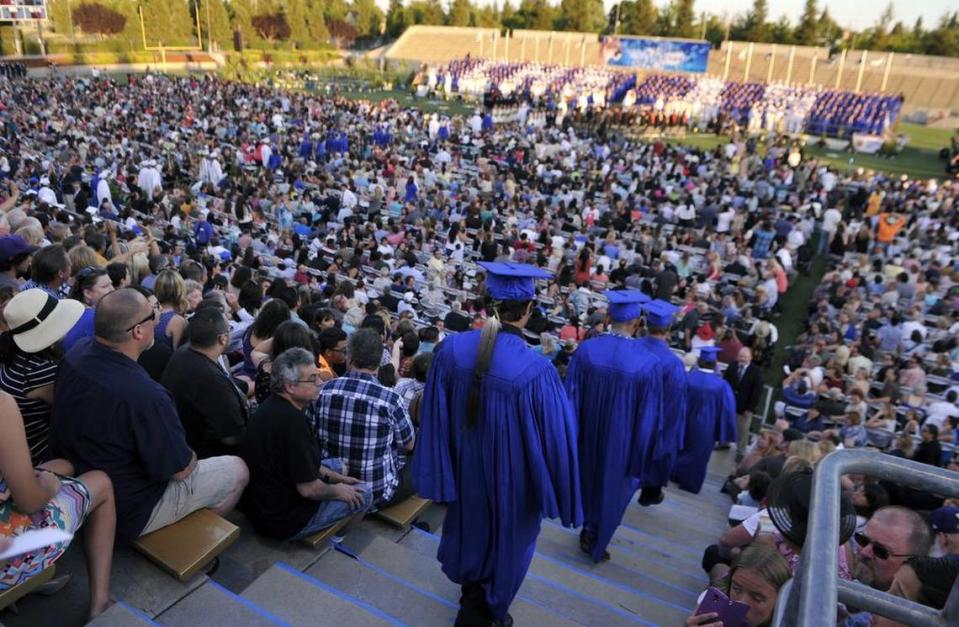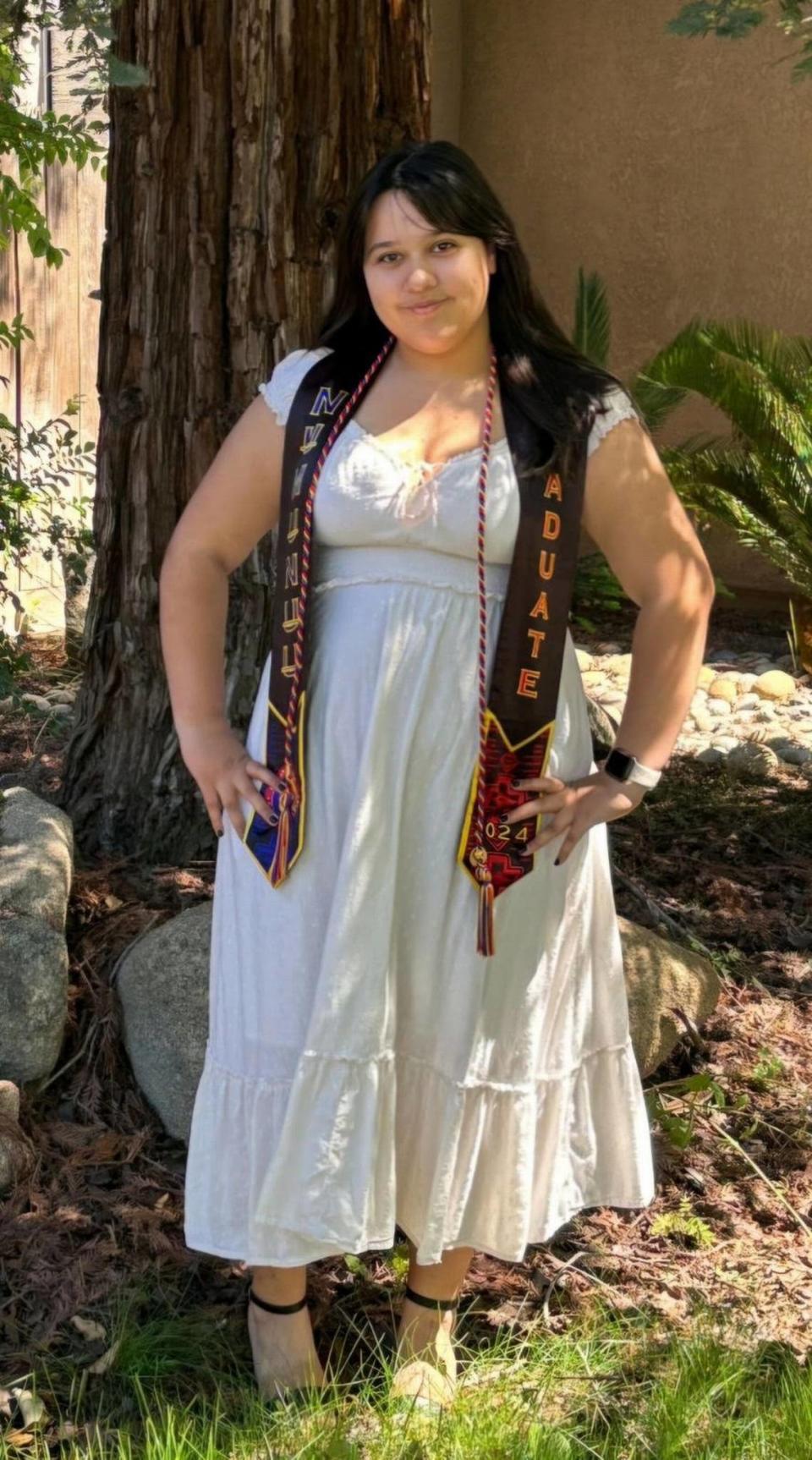Indigenous Clovis, Hanford students were blocked, at first, from wearing traditional regalia
High school graduation is usually a joyous, celebratory moment for students and their families. Yet, for some Indigenous students, it has become a time of stress over what students are allowed to wear at graduation ceremonies.
Students, like Jennie Rocha from Clovis, were told they could not wear Indigenous regalia customized by their tribal family members. Another student from Hanford was told she could not wear a hand-beaded cap because the district didn’t allow for decorations on students’ caps.
In the week leading up to Tuesday’s ceremonies, families have had to defend before school districts their students’ choices, because state law does allow for cultural and religious accessories to be worn, including Indigenous regalia. After families objected and pointed to state law, the districts changed their positions.
Having experienced a similar situation in the past, Jennie’s father, Ray Rocha, said he was not going to let his daughter’s and other students’ rights be denied. He took action, researched their rights and presented his case until his daughter was allowed to wear her stole.
“It’s a victory for other people involved that are going through (it),” he said. Besides the support from local and state organizations, Rocha also received direct support from his Comanche Tribe’s chairman, who was willing to travel from Oklahoma to Clovis to validate his daughter’s graduation stole.
“What I went through – I’m happy for it – but it was a lot. It was a long, emotional fight,” Rocha said. “It shouldn’t have happened this way.”
Indigenous Justice, a statewide nonprofit group that defends and protects Indigenous rights, has been helping families who have been challenged by their school districts, initially not allowing them to wear Indigenous regalia.
An update to the California Education Code in 2019 explicitly protects students’ rights to wear traditional tribal regalia or objects with cultural or religious significance as an adornment at school graduation ceremonies. These include but are not limited to beaded mortarboards, eagle feathers on graduation caps, traditional moccasins, leggings, basket caps, or leis, according to the American Civil Liberties Union of Northern California.
The Bee talked to two families who faced rejection from their school districts – when they requested for their students to wear Indigenous cultural accessories made or customized by their families – and about the outcomes of their cases.

Clovis questioned tribal authenticity of handmade stole
Jennie Rocha’s father, Ray Rocha, said Clovis’s school district wasn’t allowing his daughter to wear a stole gifted by the Comanche Tribe because it had “graduate 2024” wording in uppercase. Rocha also said it wasn’t the first time his children were not being allowed to represent their culture and heritage at graduation.
Jennie’s older brother, Christian, graduated in 2019, Rocha said. Then, Christian also received a stole from the Comanche Nation, but the Rocha family didn’t know about the updated protections in the Education Code, and accepted the district’s rejection.
“He graduated without wearing one,” Ray Rocha said, “and if I would have fought like I should have, he would end up wearing it at graduation.”
However, after pressure on social media and news reports on local TV stations, Clovis Unified appeared to change its stance and allow Rocha, a Clovis North High School student, to wear her Comanche stole.

Kelly Avants, spokesperson for Clovis Unified School District, said students wanting to wear cultural or religious regalia at graduation must submit a request so the district can evaluate and ensure that the item requested meets the Education Code’s criteria.
Avants said the family initially submitted a request for Rocha to wear cultural regalia and the district had approved part of it – a cord, Avants said – but the district, “questioned some customization on the stole that did not appear to be related to a culture.”
Avants didn’t clarify what the customization in question was.
In Rocha’s case, she will be allowed to wear her regalia once the district receives confirmation from the tribe that the stole as it was submitted to us is part of their traditional regalia, Avants said on Thursday afternoon.
The Bee asked Avants if it was the district who requested the family to provide validation from the Comanche Nation, claiming the stole as a cultural item. Though the district requires a request for cultural or religious regalia, she said it was the family who offered it to the district.
“We have now been told that affirmation is on its way from the tribe in question and the family has been informed that once that affirmation is received, the stole will be approved,” Avants said.
Clovis Unified has this process to “consistently respond to requests” from students who represent different religions and cultures in the district.
“We do have a graduation ceremony dress code that focuses on presenting the graduating class as a unified group in their final moments as high school students,” Avants added. “That dress code does not allow personalization or adornment of graduation robes or caps outside of what is allowed for in the Education Code.”

Before the 2019 Education Code protections were enacted, the ACLU of Northern California filed a legal complaint against Clovis Unified after they didn’t allow a senior to wear an eagle feather during his graduation ceremony. The case was settled, reaching an agreement, allowing the student to wear the feather, a day before he was scheduled to walk across the stage.
A director with Indigenous Justice, Ashley Rojas said Clovis Unified’s rigid graduation requirements made the district attempt to overstep their authority when requesting the Rocha family to alter the stole Jennie was gifted by the Comanche Nation.
Rojas said because some Indigenous tribes aren’t federally recognized, some culturally and religious items are hand-crafted at home and not all tribes have an established council or authority figure that could issue such a validation, school districts should not be requiring or asking students to verify or confirm if their Indigenous regalia is authentic.
“That is an encroachment on their rights as indigenous peoples,” Rojas said.
Hanford said beaded cap would be ‘distracting’
Favianna Berry’s daughter is Indigenous; her father’s family is part of the Confederated Tribes of Warmer Springs in Oregon.
Family members wanted to decorate a piece of Berry’s daughter’s graduation outfit to celebrate her finishing high school. Berry said she asked her daughter’s school, Hanford Online Charter High School, if she could get her daughter’s cap as soon as possible so it could be sent to Oregon for it to be decorated by her Indigenous family.
Berry said they agreed and were okay with her daughter sporting tribal regalia on graduation day, and a counselor even told her they couldn’t wait to see the cap once it was decorated.
After the hand-beaded cap came back to Hanford, Berry said the situation changed.
“Everybody was okay with it,” she said, “but when we brought back the cap to the school, they said no decorating caps.”
After speaking with Hanford Joint Union High School District’s Superintendent Victor Rosa, Berry said she was told that her daughter wearing the beaded cap could encourage other students to decorate their caps, which wasn’t allowed. If her daughter were to show up at graduation with the fully-beaded cap, then she would not be allowed to walk the stage to receive her diploma, Berry said.
Berry said she was told by the district that they were only allowing Indigenous students to wear a feather and/or beaded tassel.
“That’s just picking and choosing out of the state law, Berry said. “You’re not honoring the whole situation, you’re just picking and choosing what you want to honor.”

The Education Code’s protections also mean that a school district can “rarely” restrict students from wearing cultural accessories, the ACLU states.
“The only time a school may be able to limit a student’s right is if they can prove the item is likely to cause a substantial disruption or material interference with the graduation ceremony,” the ACLU of North and South California state in their Tribal Regalia Toolkit.
However, the ACLU also clarifies that a school can’t restrict a student’s ability to wear tribal regalia, or any object of cultural or religious significance, “because they are concerned the object might encourage students to violate school policies or engage in illegal activities.”
On Friday afternoon, Superintendent Victor Rosa told The Bee that all Hanford Joint Union High School District’s seniors are now allowed to decorate their caps for this year’s graduation ceremonies and future ones to come.
In a call with The Bee on Friday afternoon, Rosa acknowledged telling Berry that her daughter’s beaded cap would be distracting and would encourage other students to break the school’s policy last week. He said the district knows of a local tribe that beads a one-inch margin on caps, but not the entire mortar board like Berry’s daughter’s.
“We had just never encountered a Native American tribe other than what we’re used to working with here that did any beading to the level of what this tribe did,” he said. “It was just a new experience for us and something that we hadn’t addressed in our policy.”
The last time the district allowed decorated mortar boards at graduations was in 1999, Rosa said, because students then were decorating their caps with inappropriate symbols that were distracting and offensive. Since then, the California Education Code update in 2019 changed statewide regalia decoration laws for Indigenous people.
“We hadn’t caught on to the part of beating the entire cap,” Rosa said. “We only allowed for a portion of the tassel. So, obviously, that’s what’s changed now.”


